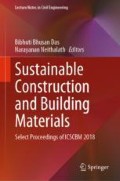Abstract
The objective of this research is to identify a new calcite-precipitating bacteria and trying to improve the strength parameters of concrete. In concrete, cracks are the most vulnerable thing through which water, minerals, and other chemicals will ingress and contacts with reinforcement of concrete and corrosion of reinforcement and degradation of concrete will happen. Overall, the durability is greatly affected due to cracks and these cracks may be micro cracks which are impossible to identify and to assess the locations of these cracks in concrete. Inspection, maintenance, and repair of cracks will be difficult for large-scale infrastructure and most of the repair techniques are chemical based, expensive, and repair techniques can be used for large size cracks but not for micro cracks In order to increase the durability of concrete against these commonly observed cracks in concrete structures, autogenous pore refinement method can be adopted. By using the principle of biomineralization, bacteria forms the calcium precipitations which is usually called microbial-induced calcite precipitation (MIC). In the present work, a different bacterial colony is chosen to see that more improvement in terms of healing capacity of concrete can be achieved compared to Bacillus family, and the bacteria were identified such that which will grow in the high alkaline media, since concrete is highly alkaline material. Bacteria are cultured in the controlled medium to get the desired concentrations of cells, and it is observed that the compressive strength of concrete is improved more than 36% and there is an improvement in other strength parameters also. And also, it is noted that there will be an effect of cell concentration on the strength development. SEM and EDAX analysis reveals the deposition of calcium carbonate.
Access this chapter
Tax calculation will be finalised at checkout
Purchases are for personal use only
References
Varenyam, A., Abhijit, M., & Sudhakara, R. (2011). Microbial concrete: Way to enhance the durability of building structures. Journal of Materials in Civil Engineering Journal of materials in Civil Engineering, 23(6), 730–734.
Harn, W., & Gupta, S. Encapsulation technology and techniques in self-healing concrete. ASCE Publications No. ISSN0899-1561.
Mian, L., & Chun, X. Q. (2016). Performance of two bacteria-based additives used for self-healing concrete. Journal of Materials in Civil Engineering, 28, 1–6.
Wang, J. Y., Soens, H., Verstraete, W., & De Belie, N. (2014). Self-healing concrete by use of microencapsulated bacterial spores. Cement and Concrete Research, 56, 139–152.
Navneet, C., Siddique, R., & Anita, R. (2012). Influence of bacteria on the compressive strength, water absorption and rapid chloride permeability of fly ash concrete. Construction and Building Materials, 28, 351–356.
Marwa, J. G., Hassan, M., Tyson, R., & Michele, B. (2014). Dicyclopentadiene and sodium silicate microencapsulation for self-healing of concrete. Journal of materials In Civil Engineering, 26, 886–889.
Jing, X., Yao, W., & Zhengwu, J. (2014). Non-ureolytic bacterial carbonate precipitation as a surface treatment strategy on cementitious materials. Journal of Materials in Civil Engineering, 26, 983–991.
Krishnapriya, S., Venkatesh, B., & Prince, A. (2015). Isolation and identification of bacteria to improve the strength of concrete. Microbiological Research, 174, 48–55.
Chen, H., Qian, C., & Huang, H. (2016). Self-healing cementitious materials based on bacteria and nutrients immobilized respectively. Construction and Building Material, 126, 297–303.
Shafagh, A., & Muhammad, N. Z. (2015). Tests and methods of evaluation of self-Healing efficiency of concrete. Construction and Building Materials, 112, 11–23.
Khaliq, W., & Ehsan, M. B. (2016). Crack healing in concrete using various bio- influenced self-healing techniques. Construction and Building Materials, 102, 349–357.
Filipe Bravo da, S., Nele, D. B., Nico, B., & Willy, V. Production of non-axenic ureolytic spores for self-healing concrete applications. Construction and Building Materials, 93, 1034–1041.
Luo, M., & Qian, C. X. (2015). Factors affecting crack repairing capacity of bacteri based self-healing concrete. Construction and Building Material, 87, 1–7.
Qureshi, T. S., Kanellopoulos, A., & Tabbaa, A. (2016). Encapsulation of expansive powder mineral within a concentric glass capsule system for self-healing concrete. Construction and Building Material, 121, 629–643.
Zhu, Y., Zhang, Z. C., Yao, Y., Xue, M. G., & Ying, Z. Y. (2016). Analysis of crack microstructure, self-healing products, and degree of self-healing in engineered cementitious composites. Journal of Materials in Civil Engineering, 28, 1–10.
Jing, X., & Yao, W. (2014). Multiscale mechanical quantification of self-healing concrete incorporating non-ureolytic bacteria-based healing agent. Cement and Concrete Research, 64, 1–10.
Sarda, D., Lele, S. S., & Sarode, D. D. (2009). Biocalification by Bacillus pasteurii: A novel application. Jind Microbiail Biotechnol, 36, 1111–1115.
Jonkers, H. (2008). Self-healing concrete: A biological approach. Springer Series in Materials Science, 100, 195–204.
Ghosh, P., Mandal, S., Chattopadhyay, B. D., & Pal, S. (2005). Use of microorganism to improve the strength of cement mortar. Cement and Concrete Research, 35, 1980–1983.
IS 10262: 2009. Concrete mix proportioning.
IS 456: 2000. Code of practice for plain and reinforced concrete.
IS 12269: 1987. Specification for 53 Grade Ordinary Portland Cement.
IS 383: 1970. Specification for coarse and fine aggregates from natural sources for concrete.
Author information
Authors and Affiliations
Corresponding author
Editor information
Editors and Affiliations
Rights and permissions
Copyright information
© 2019 Springer Nature Singapore Pte Ltd.
About this paper
Cite this paper
Shashank, B.S., Dhannur, B., Ravishankar, H.N., Nagaraj, P.S. (2019). Study on Development of Strength Properties of Bio-concrete. In: Das, B., Neithalath, N. (eds) Sustainable Construction and Building Materials. Lecture Notes in Civil Engineering , vol 25. Springer, Singapore. https://doi.org/10.1007/978-981-13-3317-0_38
Download citation
DOI: https://doi.org/10.1007/978-981-13-3317-0_38
Published:
Publisher Name: Springer, Singapore
Print ISBN: 978-981-13-3316-3
Online ISBN: 978-981-13-3317-0
eBook Packages: EngineeringEngineering (R0)

